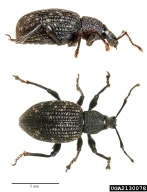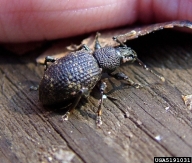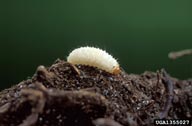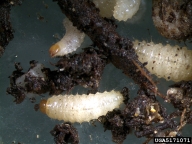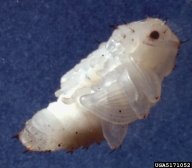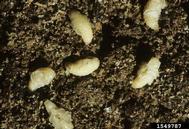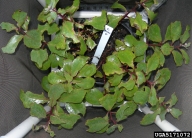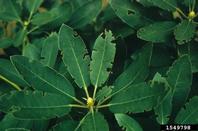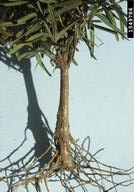Black vine weevil
Otiorhynchus sulcatus (Fabricius) (Coleoptera: Curculionidae)
Orientation to pest
The black vine weevil, Otiorhynchus sulcatus (Fabricius), is a weevil that is likely native to some or all of Europe that has invaded North America, Japan, New Zealand, Australia, and parts of southern South America. The mechanism of these invasions has been movement of the insect in balled nursery stock plants. This species feeds on over 100 species of plants. Larvae are the main damaging stage, feeding in the soil on plant roots. Young larvae eat the fine roots, but the following year, mature larvae destroy the larger roots as well. Unlike the white grubs of scarabs such as Japanese beetle (Popillia japonica Newman), weevil larvae such as those of black vine weevil, are less C-shaped and lack legs. Adults feed at night, notching the leaves of their host plants, but damage from adult feeding is not severe. Leaf notching is, however, a useful indicator of the presence of this nonflying, nocturnal insect whose larvae are out of sight in the soil. The most common overwintering stage of this insect is the young larva, but sometimes adults too overwinter. In general, in the eastern United States, adults emerge in June. Black vine weevils are pests in greenhouses and forestry nurseries where planting stock is produced, to both potted and field-grown plants.
Hosts commonly attacked
Plants fed on by black vine weevil include many woody and non-woody species, including strawberry (Fragaria), yew (Taxis), spruce (Picea), hemlock (Tsuga), rhododendron (Rhododendron), grape (Vitis), and cyclamen (Cyclamen).
Distribution
The black vine weevil is found in the northeastern and north central parts of the United States and adjacent parts of eastern Canada, and from Alaska south to California.
Images of black vine weevil
| Figure 1. Adults of black vine weevil, Otiorhynchus sulcatus, are flightless (wing covers do not open) and nocturnal. | Figure 2. Larvae of black vine weevil are cream colored, with a brown head and no legs. | Figure 3. Pupae of black vine weevil occur naked in the soil |
| Figure 4. Adult black vine weevils notch edges of host leaves (sedum plants, left and rhododendrons, right). | Figure 5. Damage yew seedling roots from black vine weevil larvae. | |
Important biological control agents related to this pest species
Specialized parasitoids or predators of this species have not been reported. Most attention has been on various species of nematodes (e.g., Heterorhabditis heliothidis [Kahn, Brooks, and Hirschman]) and fungal entomopathogens (e.g., Metarhizium anisopliae [Metchnikoff] Sorokin), which have been developed for use as biopesticides against this species with varying degrees of success depending on such things as soil temperature.
Web links for information on black vine weevil
- Woody Ornamental IPM fact sheet | Pennsylvania State University
- Fact Sheet | UMass Extension | Massachusetts Landscape, Nursery, and Urban Forestry Program
- Fact Sheet | Tri River Area, Colorado State University Extension
Articles
- Haukeland, S. and T. Lola-Luz. 2010. Efficacy of the entomopathogenic nematodes Steinernema kraussei and Heterorhabditis megidis against the black vine weevil Otiorhynchus sulcatus in open field-grown strawberry plants. Agricultural and Forest Entomology 12(4): 363-369.
- Ansari, M. A., F. A. Shah, and T. M. Butt. 2008. Combined use of entomopathogenic nematodes and Metarhizium anisopliae as a new approach for black vine weevil, Otiorhynchus sulcatus, control. Entomologia Experimentalis et Applicata 129: 340-347.
- Reibnitz, C. von and G. F. Backhaus. 1992. Analysis of the incidence and control of Otiorhynchus sulcatus in tree nurseries. Results from a survey in Lower Saxony and Schleswig-Holstein. Gesunde Pflanzen 45(2): 54-60. (in German)
